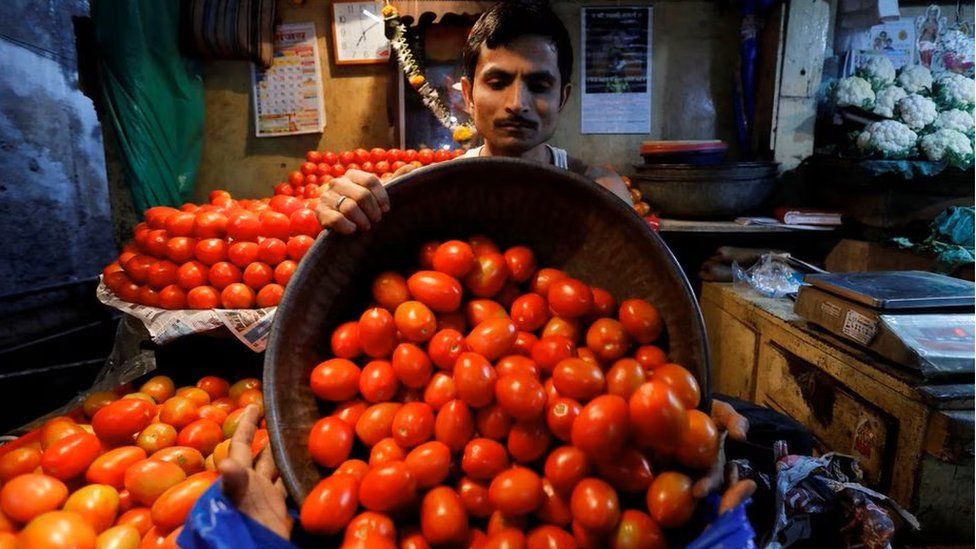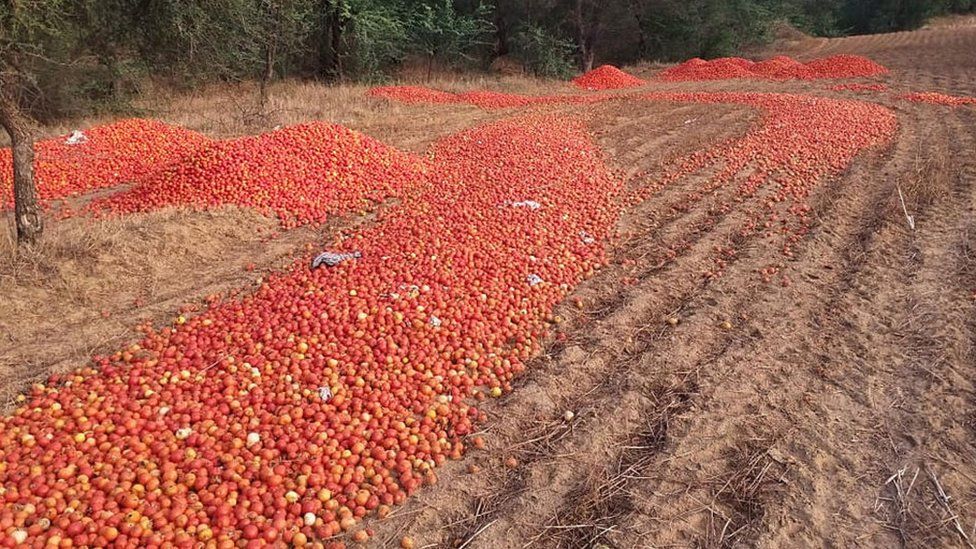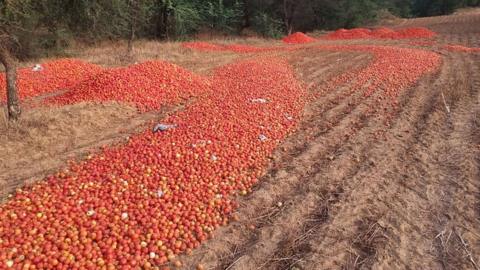
The conundrum over the tomato in India right now is not whether it’s a fruit or a vegetable – it’s that it has become expensive, and ridiculously so.
The price of the everyday staple has been climbing steeply for the past couple of weeks, and now stands at almost 200 rupees (£2; $3) a kilo in certain parts of India – a sharp shift from the usual 40-50 rupees.
The costly tomato has wreaked havoc on wallets, in kitchens and even on the streets.
McDonald’s recently made news – not for adding a new dish – but dropping tomatoes from its menu in most of its outlets in northern and eastern India. It cited the unavailability of quality tomatoes “due to seasonal crop issues” as the reason.
The skyrocketing prices have been particularly hard on India’s middle and lower classes, who make up the bulk of the population.
In the western city of Pune, a vegetable seller allegedly smacked a customer in the face with a weighing scale for bickering over the price of 250g of tomatoes.
In India’s holiest city Varanasi, a politician reportedly hired two bouncers to prevent people from haggling over tomato prices at his shop.
There have been reports of people stealing tomatoes from fields and hijacking tomato-laden trucks.
The BBC is not responsible for the content of external sites.
Allow Twitter content?
This article contains content provided by Twitter. We ask for your permission before anything is loaded, as they may be using cookies and other technologies. You may want to read Twitter’s cookie policy and privacy policy before accepting. To view this content choose ‘accept and continue’.
The BBC is not responsible for the content of external sites.

Experts say that bad weather conditions have damaged crops, fuelling shortages in the market and a mismatch between demand and supply. The government has said that the soaring prices are a “temporary problem” and that they will drop in the coming months.
Some states have started selling tomatoes at reduced prices at government-run or farmer-backed outlets to help consumers. On 30 June, the Indian government launched a Tomato Grand Challenge Hackathon in Delhi to encourage the public to share ideas to combat the escalating prices.
The tomato holds a surprising amount of sway over Indian cooking – it’s added to almost every dish. So when it becomes scarce and expensive, it becomes the subject of headlines and even political rows.
Economists say the steep price rise could disrupt India’s delicate inflation balance, pushing retail inflation towards 5.5% in July-September from 4-5% in April and May.
Ironically, close to two months ago, farmers in India dumped crates of tomatoes on the road after prices crashed to 2-3 rupees a kilo in the wholesale market as supply exceeded demand.
Farmers resorted to the same measure last year to draw attention to their plight and, in March, farmers in Maharashtra state took out a protest march to demand higher prices for onions.
India often faces supply-demand challenges when it comes to perishable, but essential, vegetables like the onion and tomato. Both crops are grown almost around the year and produce from different states hits the market during different months.
This year, a bumper crop of tomato was followed by a poor harvest season.
“The current bout of tomato prices is actually a result of unseasonal rains during March-April-May in tomato-growing areas, particularly Kolar belt [in southern Karnataka state], which has the largest tomato market of the country,” says, Ashok Gulati, farm economist.
“From mid-June, the supplies have shrunk, while demand pressures have mounted, leading to spikes in fresh tomato prices,” he adds.

Mr Gulati says the excessive rains in north-western India are likely to put further pressures on supply.
“Significant areas are also reeling under floods, especially Himachal and Uttarakhand states. Supply lines during heavy rains often get displaced,” he says.
Anil Malhotra, an Agricultural Produce Market Committee (APMC) member, told PTI news agency that though tomato prices escalate every monsoon, he had never seen them this high.
“There is a major dip in supply due to rains. Around half our stock, which we get from Himachal Pradesh, got damaged,” he said.
Arvind Malik, a tomato farmer from Haryana state, told the Guardian newspaper that while he usually sold 30,000kg of tomatoes every year, this year he could only harvest half of that as his crops had been destroyed by pests.
“Experts told us that irregular weather – sudden rise and decline in temperatures – is the reason behind the diseases in our tomatoes,” he said.
So how does India overcome this supply-demand gap? A straightforward solution would be to just store excess produce for the proverbial – and in this case, literal – rainy day.
But experts say that this is easier said than done because tomatoes are highly perishable and tend to go bad after a few weeks even in cold storage.
Mr Gulati says that one way to stabilise supply is to incentivise protected cultivation of tomatoes to save the crop from extreme heat or unseasonal heavy showers.
Another step is to process tomatoes into puree, which can help consumers shift to processed tomatoes when prices of fresh tomatoes are running high. “But to promote processing of tomatoes, the government has to incentivise the processing and lower GST [general sales tax] on tomato puree from 12% – 5%,” says Mr Gulati.
“Overall, a value chain approach has to be adopted to de-risk the vegetable from production to consumption, but the framework is absent right now.”
BBC News India is now on YouTube. Click here to subscribe and watch our documentaries, explainers and features.

Read more India stories from the BBC:


